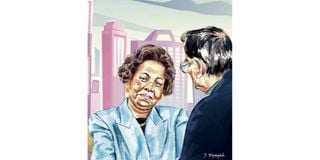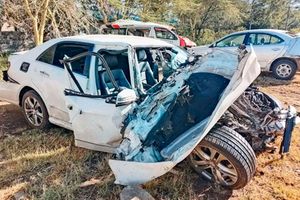Premium
Fulfilment that came with treating four generations

Mrs Karanja's post-operative recovery was uneventful and she went home after a week.
What you need to know:
- At an emergency operation, I removed an acutely inflamed gallbladder packed with stones, with one of them blocking the gall-bladder causing an empyema.
Her post-operative recovery was uneventful and Mrs Karanja went home after a week.
A long surgical practice has its own rewards. Like, I operated on a lady in 1961 just when I started out as a surgeon in Nairobi; and carried out a ritual circumcision on her great grandson just before I retired in 2014.
It was at midnight in June, 1961 when Dr Tom Mathews rang me and said. “I have a Mrs Karanja with me, who has all the signs and symptoms of acute cholecystitis; she is a book picture. But for the fact that she is African, I would have labelled her as such.”
Dr Mathews was not being racial, but in those days, the indigenous people rarely suffered from gallstones, acute appendicitis, duodenal ulcers or coronary infarct.
Surprisingly, diseases have racial, regional and ethnic bias and though Mrs Karanja was a classical picture of acute cholecystitis, her Kikuyu origin ruled it out. The pathology is common now and its causation arouses a lot of research. Change of diet and lifestyle seems to be culpable.
Post-operative recovery
“Please send her to the Casualty here and I will sort her out.” I said.
Despite being an African, Mrs Karanja had acute cholecystitis. At an emergency operation, I removed an acutely inflamed gallbladder packed with stones, with one of them blocking the gall-bladder causing an empyema. Her post-operative recovery was uneventful and Mrs Karanja went home after a week.
The Karanjas went out of my orbit until the coup in August 1982. I was attached to Kenyatta National Hospital in an honorary capacity for three sessions a week associated with teaching. I was also on the emergency roster.
My phone rang on the night of the coup and the doctor from A&E was on the phone and he said. “I have a young man, Peter Karanja, here with me, who was struck by a stray bullet in his thigh and is bleeding fiercely from the wound. He needs to go the theatre immediately to stop the haemorrhage.”
“Is the bullet still lodged in his thigh?” I asked.
“Yes,” replied the doctor. “That’s the reason I am ringing you. I think the bullet has hit the femoral artery, which might need a repair.”
“Please arrange the theatre and the on-call anaesthetist. I am on my way.”
I went straight to the theatre and found Peter in the anaesthetic room. I vaguely remembered him because he accompanied his mother the night she lost her gallbladder.
When I opened the wound on Peter’s thigh, I discovered that the bullet was lodged actually in his femoral artery, which bled further when I removed it. It ceased when I clamped artery above and below the hole left behind by the bullet.
I repaired the artery, released the clamps and closed the wound. When I left the theatre, I bumped into my old patient, Mrs Karanja, who had been informed by the Sister of the Emergency Ward. She blessed me profusely for coming out on the ‘coup-night’ to save her son! With her blessings heaped on me, I didn’t have the heart to tell her that I was not aware of the coup until she told me, though it explained the unusually quiet roads.
Roll on, another two decades and one morning I was rung by Mother Superior at Loreto Convent, Msongari and she said. “I have a little girl in second form, complaining of tummy-ache. She has vomited twice since she came to school. The nurse in the clinic has seen her and suspects that the little girl has acute appendicitis. I was wondering if I could send her to you.”
“Have you informed the parents?” I asked.
“Yes,” she replied. ”Apparently, you are their family-surgeon. They advised me to send her to you and they will meet you in the hospital.” She had coined a new term – family-surgeon!
When I examined Elisha in the Children’s Ward in the Nairobi Hospital, I confirmed that she had acute appendicitis. Her parents, Mr Peter Karanja and his wife had arrived. We exchanged greetings and the father readily signed the consent form. I removed a gangrenous appendix from Elisha’s belly and left a ‘bikini’ scar, as my permanent autograph. She had talked to me before she went ‘under’. “I am told that you leave invisible small scars after surgery. You are known to leave a tiny scar after appendix operation, which even the briefest bikini doesn’t show.”
“I will try, depending on how easy your appendicectomy is.” I promised. She did get a ‘bikini’ scar. Though her appendix was gangrenous and on the verge of bursting at the tip, its position was favourable to easy removal and I didn’t have to extend my tiny incision.
Bikini scar
The final climax to this saga arrived in 2014, just before I retired, when Prof Ogutu rang me one morning and said. “Now this might sound like asking the Pope to carry out a christening, but I wonder if you can circumcise a baby I delivered last night. The mother’s name is Elisha and she showed the tiny scar you left after her appendicectomy. I think she called it the bikini scar. She also informed me that you are her family-surgeon and though she is married now, her husband, Eric, has agreed to uphold the family tradition. He would also like to know if you can be the same to his immediate and extended family.”
“I will be delighted to circumcise Elisha’s boy because I carried out a cholecystectomy on his great grand-mother in 1961.
“That makes him the fourth generation and before I retire, I would covet that particular distinction. For the same reason, I have to decline the kind invitation of Eric to be their family-surgeon. But I can happily suggest to him the name of the surgeon who is inheriting my practice. I don’t think, my inheritor will appreciate the title of family-surgeon tagged on him. The term is old-fashioned and outdated; the special designation is likely to die with me. The title only applies to family-doctors. Even they have exalted themselves to the position of family-physicians!”





